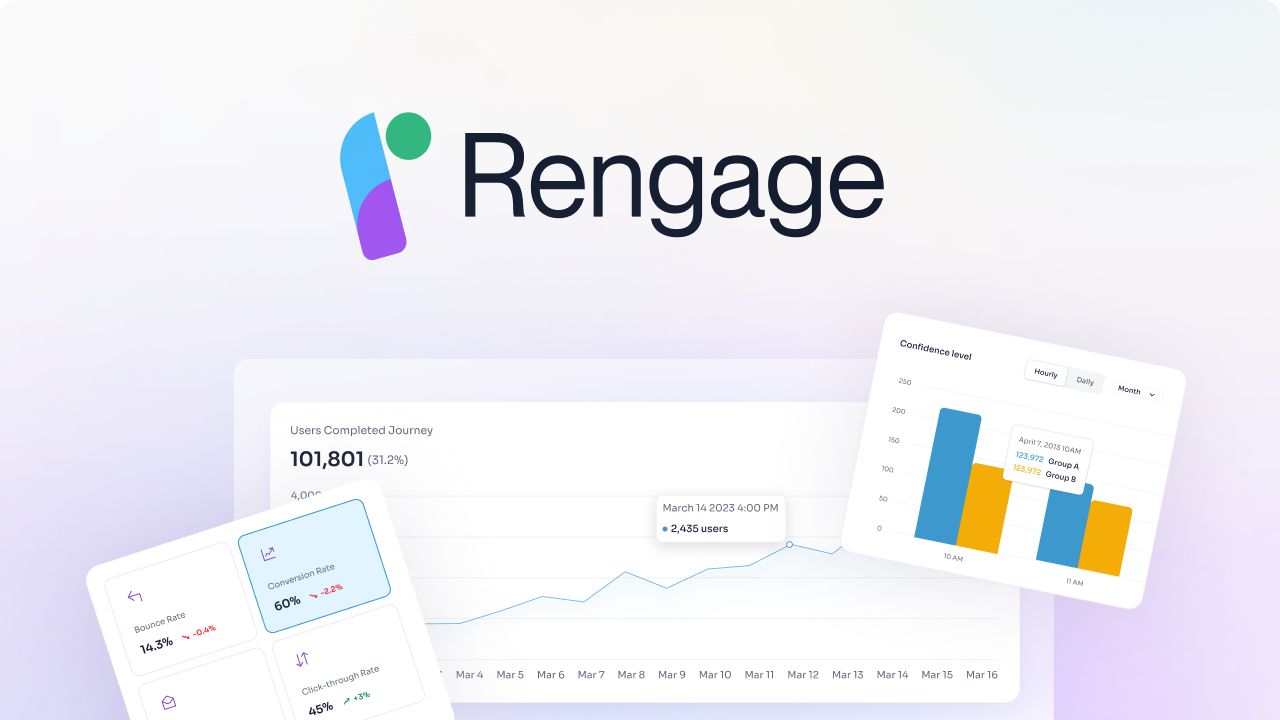Are you looking to enhance customer segmentation analysis through effective Customer Data Platform Implementation? Mastering this process can lead to improved customer insights and personalized marketing strategies. This blog provides insights into the steps for CDP implementation and its benefits, helping you achieve your objectives and optimize customer experiences.
Rengage's solution, drive loyalty and growth, can be a game-changer. It assists you in effectively implementing CDP for better Customer Segmentation Analysis. By following the guidelines, you can capitalize on the benefits of CDP implementation for your business.
Table of Contents
- A Guide to CDP Implementation
- Customer Data Platform Implementation
- Assess Your Existing Data Landscape
- Choose the Right CDP Solution
- Data Ingestion and Integration
- Benefits of CDP Implementation
- Create Personalized Experiences That Drive Loyalty and Growth with Rengage — Book A Free Demo Today
A Guide to CDP Implementation

CDPs are the backbone of any data-driven operation. They are a key piece of technology that offers a streamlined view of your customers. With a CDP, you can aggregate all of your customer data and organize it in one place.
Key Aspects of Customer Data Platform (CDP) Implementation
Data unification is the first critical step in implementing a CDP. Unifying data is the process of collecting information about a customer from multiple channels and platforms, such as social media, CRM systems, and websites, into a single, centralized source. This single source of truth allows companies to develop insights based on all data sources.
Data Standardization in a CDP
You should then standardize this data in your CDP. Standardizing data is the process of cleaning it, ensuring that data fields are correctly labeled, and organizing it for quick and easy retrieval.
Data Enrichment for Deeper Insights
The data needs to be enriched. Enriching data is a process of associating data with other types of data to provide a more comprehensive view of individual customers. The goal is to provide a more holistic view of customer behavior and preferences.
Tracking Interactions with Your Brand
Track and measure customers' interactions with your brand. The next step in implementing a CDP is to track and measure customer interactions with your brand. This includes tracking website visits, social media engagement, email opens, and other online interactions.
Segmentation and Targeted Marketing
Use this data to segment and personalize your marketing efforts. The final step in implementing a CDP is to use your data to segment and personalize your marketing efforts. By dividing your audience into segments based on demographic and behavioral data, you can deliver targeted messages that resonate with individual customers.
Related Reading
- Customer Data Infrastructure
- Omnichannel Analytics
- Customer Data Integration
- Predicting Customer Behavior
- Marketing Data Platform
- Customer Data Platform Vs Data Management Platform
- Customer Data Platform Use Cases
- Best Customer Data Platform
- Customer Data Platform Capabilities
- Customer Data Platform Tools
- How To Choose Cdp
Customer Data Platform Implementation

Goals of CDP implementation
Having a clear goal in mind is essential before implementing a CDP. For example, one of the primary goals of CDP implementation is to improve customer service. One can also focus on personalization in marketing, improving customer experience, or boosting customer loyalty. The purpose of implementing a CDP ultimately determines the features and functionalities that should be included in the solution.
Other common goals include:
- Personalized marketing
- Improved Customer Experience
- Enhanced Customer Service
- Increased Customer Loyalty
Meeting these goals will ensure that the CDP is correctly implemented.
Assess Your Existing Data Landscape

Assess Data Sources
When preparing to implement a CDP, I must first conduct a comprehensive audit of the organization's existing sources of customer data. This can include customer data stored within systems like CRM, marketing automation, website analytics, loyalty programs, point-of-sale systems, and social media platforms. By identifying all the channels that contain customer data, I can ensure that all relevant information is integrated into the CDP for a comprehensive view of each customer.
Evaluate Data Quality
Once I have identified the sources of customer data, it's essential to assess the quality of the data. This evaluation should include checking the data's accuracy, completeness, and consistency. It's crucial to address any inconsistencies, missing information, or duplicate entries to ensure that the customer profiles generated by the CDP are reliable. I can create a solid foundation for data-driven decision-making by addressing data quality issues before integration.
Examine Data Accessibility
Another critical consideration when implementing a CDP is the accessibility of customer data across different teams within the organization. I need to determine if data silos exist that inhibit a holistic view of the customer journey. By implementing a CDP, I can break down these silos and make customer data accessible to various departments such as marketing, sales, and customer service. This accessibility allows for better team collaboration and coordination for more effective customer engagement.
Related Reading
- Customer Retention Automation
- Customer Data Integration Best Practices
- Real Time Customer Segmentation
- Chat CDP
- Benefits Of A Customer Data Platform
- Customer Segmentation Solutions
- Omnichannel Measurement
- AI Customer Segmentation
- AI CDP
- Customer Data Platform GDPR
- Customer Data Platform Costs
- CDP Personalization
Choose the Right CDP Solution
Scalability
When selecting a CDP solution, scalability is a crucial factor. A CDP that can scale with your growing data needs is essential. You must consider the volume and variety of data you expect to collect in the future.
Security and Compliance
Another essential consideration when choosing a CDP is security and compliance. Your selected platform should meet all relevant data security and privacy regulations, such as GDPR and CCPA. Data security is paramount, so choose a vendor with a strong track record of protecting customer information.
Functionality
Evaluate the specific features and functionalities offered by different CDP solutions. Does the platform offer the capabilities you need to achieve your goals, such as customer segmentation, journey mapping, and real-time data personalization?
Ease of Use
Consider the technical expertise required to implement and manage the CDP platform. Choose a user-friendly solution for your team that integrates seamlessly with your existing marketing technology stack.
Budget
CDP solutions can vary significantly in cost. Before starting your evaluation process, determine your budget for the platform and associated implementation services.
Activation, Conversion, and Growth with Rengage

We provide a comprehensive solution for managing and enhancing customer journeys, delivering insights and measurable outcomes with no code. We accelerate your customer journey from onboarding activation to conversion and churn. Enabling customers to unlock revenue from their existing users.
With Rengage, you can get insights into your segments, run campaigns with an intuitive journey manager, and get insights to measure how your journeys impact users conversion through our Journey Moments and Journey Builder features.
- Journey Moments: insights into your micro-segments
- Journey Builder: intuitive multi-channel marketing automation
- Insights prediction and attribution
Book a free demo to learn how to transform customer interactions into personalized experiences that drive loyalty and growth.
Data Ingestion and Integration

Data ingestion is the process of collecting and integrating customer data from various sources into your CDP. This stage involves establishing connections between your data sources and the CDP platform.
APIs (Application Programming Interfaces)
Many data sources offer APIs allowing you to extract and transfer customer data to the CDP securely. These APIs act as intermediaries, enabling communication between your existing systems and the CDP platform.
Data Pipelines
For complex data integrations, you should build data pipelines. These automated processes continuously move data from various sources to the CDP, ensuring your customer profiles are always up-to-date.
Custom Integrations
In some cases, custom integrations might be required to connect specific data sources that don't have readily available APIs. This might involve working with IT specialists or the CDP vendor to build customized connectors.
Ensuring Data Quality and Consistency
During data ingestion, it's crucial to ensure data quality and consistency. This might involve data cleansing techniques to address missing information, duplicate entries, and formatting inconsistencies.
Benefits of CDP Implementation

Unified Customer View
CDPs break down data silos and create a single, holistic view of each customer. By integrating data from various sources, you better understand customer demographics, preferences, purchase history, and interactions across different channels. This 360-degree view lets you personalize experiences and tailor marketing campaigns to each customer.
Enhanced Marketing ROI
Targeted marketing campaigns based on customer data insights lead to higher conversion rates and a better return on investment (ROI) for your marketing efforts. CDPs enable you to segment your audience based on specific criteria and deliver highly personalized messages that resonate with each customer group.
Improved Customer Experience
A unified customer view empowers you to deliver a seamless and consistent customer experience across all touchpoints. With a CDP, you can anticipate customer needs, resolve issues faster, and provide personalized support that fosters customer satisfaction and loyalty.
Data-Driven Decision Making
CDPs provide valuable customer data insights that can inform strategic business decisions. You can gain insights into customer behavior, identify churn risks, and optimize marketing campaigns based on real-time data. This data-driven approach allows you to make more informed decisions that drive business growth.
Increased Operational Efficiency
CDPs can streamline marketing and sales processes by eliminating the need to manage data from multiple sources. With centralized customer data, teams can collaborate more effectively and focus on delivering better customer experiences.
Improved Regulatory Compliance
CDPs can help businesses comply with data privacy regulations like GDPR and CCPA by providing data governance and access control tools. You can ensure customer data is managed responsibly and securely within the platform.
Create Personalized Experiences That Drive Loyalty and Growth with Rengage — Book A Free Demo Today
Rengage provides a comprehensive solution for managing and enhancing customer journeys, delivering insights and measurable outcomes without code. Our platform accelerates your customer journey from onboarding and activation to conversion and churn. With Rengage, you can unlock revenue from your existing user base.
Insights into Your Segments
We provide insights into your micro-segments, allowing you to understand your audience better and tailor your marketing strategies accordingly. This level of segmentation ensures that you can effectively reach out to each group with personalized messaging and offers, increasing the likelihood of conversion and customer retention.
Run Campaigns with Journey Manager
Our Journey Manager feature allows you to set up and run your marketing campaigns easily. This tool allows you to create personalized journeys for your customers, guiding them through the steps required to achieve conversion. This intuitive platform ensures that you can effectively design and launch marketing campaigns without the need for extensive technical knowledge.
Measure the Impact of Your Journeys
Rengage offers Journey Moments and Journey Builder features that enable you to measure how your customer journeys impact user conversion. With this data, you can optimize your strategies, focusing on what works best for your audience and driving better results. By understanding the customer journey, you can refine your marketing strategies to enhance customer loyalty and grow your business.
Book a Free Demo
If you want to transform your customer interactions into personalized experiences that drive loyalty and growth, book a free demo with Rengage today. Our team will walk you through the platform, showing how easy it is to manage your customer journeys and achieve better results. Schedule your demo today and start unlocking the potential of your customer data.
Related Reading
- CDP Marketing Automation
- Customer Data Platform Vs Marketing Automation
- Ecommerce Cdp
- Totango Competitors
- Centralized Marketing Data
- Customer Data Management Best Practices
- Segment Alternatives
- Blueconic Cdp
- Emarsys Competitors
- Actioniq Competitors
